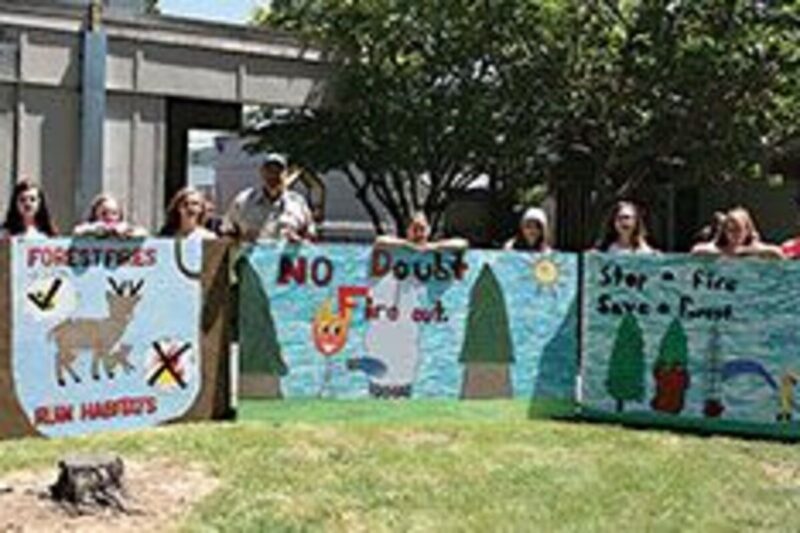Sean C. Morgan
Fire officials have selected fire prevention posters by three Sweet Home children to post near forest areas in the area.
The grand prize posters were created by Madison Lee, fifth grade, of Foster School; Brooke Dodge, fourth grade, of Foster; and Jessica Maynard, fourth grade, of Hawthorne.
Sweet Home High School art students copied the young artists’ posters onto 4-foot-by-8-foot plywood signs to be posted along roadsides. They included sophomores Egan Shamek, Kaylee Dougherty, Makayla Stafford, Courtney Cross, Amber Doles and Dakota Garcia and senior Taya Cross.
This is the 33rd year of the contest, said Neil Miller, forest protection supervisor with the Oregon Department of Forestry Sweet Home Unit. The contest was run in cooperation with Larae Gullory, prevention coordinator with the U.S. Forest Service.
The contest included students from the fourth grades at Foster, Hawthorne and the Sweet Home Charter schools. It also included third- and fifth-grade students in blended classrooms.
Each class had prizes and ribbons for first through third place, Miller said. Three grand champions were chosen from among those winners.
Thursday, fire officials mounted the fire prevention signs at Shea Point east of Sweet Home, at Sunnyside Park and 2½ miles up Upper Calapooia Drive.
Fire season is expected to begin around the Fourth of July, Miller said, although it’s subject to change depending on the weather.
The annual burn ban will begin at midnight on Monday, June 16, and the Sweet Home Unit fire crew will start working.
Regulated use, which limits fires and other activities on ODF-protected land, rural areas around Sweet Home and up the Quartzville Corridor on Bureau of Land Management property, usually begins during the week following Independence Day.
The Oregon Legislature has added restrictions during fire season, Miller said. During the 2013 session, the legislature passed a bill prohibiting the release of sky lanterns (paper bags with candles), discharging exploding targets or discharging tracer ammunition during fire season or within one-eighth of a mile of forest protection district lands.
A first-time offense is a class A violation, with a presumptive fine of $435.
(National forests also restrict possession and discharge of exploding targets, a class B misdemeanor with a fine of $5,000 for individuals and $10,000 for organizations.)
“There’s been evidence that some of these targets will combust and start a fire under specific circumstances,” Miller said. That mostly happens when users are not following manufacturers’ suggested directions.
Explosive targets caused a two-acre fire off Highway 228 west of Sweet Home a couple of years ago, Miller said, and regular ammunition once caused a fire on McDowell Creek when shooters fired multiple times into a stump. The hot metal in the stump eventually caused it to ignite.
“Tracer rounds, I know, start fires,” said Carl Lemmer, forest officer. “We did the 75-acre Thomas Creek fire years ago.”
That was in 1996, Lemmer said, and that’s when Weyerhaeuser started closing gates, he said.
The fire danger for the Willamette Valley including forestland in the foothills of the Coastal and Cascade Ranges, is currently low, however, conditions are drier than normal. The National Interagency Fire Center expects the potential for large fires to rise to above normal in June and remain above normal through August.
Hundreds of firefighters have been hired in Oregon to suppress wildfires here and in other parts of the country. These firefighters are currently completing the training needed to do their work effectively and safely. Locally, fire school will be held later this month.
“The actions that visitors to public lands and homeowners can take now to help prevent and prepare for wildfires ultimately creates safer conditions for firefighters to work in,” said Sean Stafford, Fire Management Officer for the Willamette National Forest and BLM Eugene District. “It really takes everyone working together to manage and lessen the impacts of wildfire.”
One of the best ways visitors can prevent human caused fires on public lands is by putting out their campfires; a fully extinguished campfire is cool to the touch. It’s also important to know what campfire restrictions may be in effect. Some areas, such as Wilderness Areas require a camp stove.
Fire prevention and pre-season preparations on private lands are important too. Residents are encouraged to be proactive, and take advantage of the resources available to help make their homes and neighborhoods more fire-ready and more fire-adapted.
“It’s a good time to think about the actions homeowners can take to protect their homes from wildfire, especially if you live in or near a forested area,” said Tom Fields with the ODF. “This includes keeping your surroundings lean, clean and green. Clear out dead or fire-prone vegetation around the home and remove leaves and pine needles from the roof and gutters. These little things can help your home survive an approaching wildfire.”
These kinds of preparations also support the year-round efforts by agencies to reduce hazardous
fuels on public lands and around private lands.





